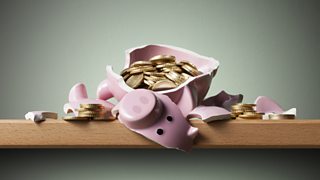The secrets behind the success of discount stores
Poundland, Lidl, B&M Bargains and Primark are thriving successes on the High Street, while more mainstream retailers have seen their profits hit.
Why is the flourishing end of the high street the cheap one? Just how do the discounters keep their prices so low? And is it just the bargains that keep us coming back? The Bottom Line investigates.
So, what are the secrets to these discounters’ success?

-
![]()
The Bottom Line: The discounters
How do discounters undercut mainstream retailers?
-
Stack 'em high, sell 'em cheap
How are stores like Poundland and B&M able to offer stuff at such low prices and stay afloat?
There’s a definition for these retailers, and it’s “limited assortment discount stores”. And it’s in this definition that that answer lies.
B&M’s Simon Arora looked at what Lidl and Aldi were doing in the groceries market, and realised that exactly the same thing could be done within toyware, homeware, and DIY: offer a smaller range of products than you would expect to see elsewhere. “You concentrate your volumes on a limited selection of just the bestsellers,” says Simon. “You buy deep volumes, directly from a factory, rather than buying a broad range from local middlemen or wholesalers.”
B&M have become 7% of the UK toy market. Whereas Toys R Us would have been offering between 30,000 and 40,000 different products, in B&M it’s just the best 500.
How shops are 'priming' you to spend money

How shops try to make the most of your cognitive processes to get you to spend more money.
Choice – the arch enemy of simplicity – is expensive, says Catherine. Stores like Tesco think in terms of “good, better and best”: they need a good brand of baked beans, a better brand and a best brand – even if the reality is that most people are going to buy Heinz.
Choice – the arch enemy of simplicity – is expensive.
This approach means they might have up to 60,000 lines in a shop. In contrast, Aldi or Lidl might have just 10,000 to 15,000 single items in a store.
-
Smaller margins
The “magic”, as Simon describes it, comes from thinking about the selling price not in terms of “what’s the most we can charge for this?”, but in terms of price minimisation. “Our mindset is, what’s the lowest we can charge for this product and still make it an acceptable profitability?” says the B&M boss.

Taking a dog basket as an example, Simon says his company would aim to offer an RRP that is half that of a category specialist like Pets at Home. They wouldn’t want to stock it at all unless it was at least 20% cheaper. Whereas B&M’s gross margin (the mark up from the cost price to the price the customer pays) is just 34%, a category specialist will need to apply a 60% gross margin in order to cover their costs. This is because as well as the products that fly off the shelf, there will be lots of product lines that don’t sell very much at all.
In the case of Poundland, for every pound that a customer spends, it’s pennies that is the actual bottom line for them. “You can’t afford to be greedy,” Barry says. “We look for small returns but lots of them. High volume.”
-
Keeping things simple
There are other crucial ways that these discounters cut their own costs. B&M’s stores are clean, well-lit and easy to navigate, but there are no cafes, no fancy shop windows, no experiential centres and no loyalty cards. “All these extra bells and whistles, they go into the cost,” says Simon. The shopping experience in B&M is you see the product on the shelf and if you like the price you take it to the check out and you pay, says the bargain shop boss. “We keep things simple and honest.”
-
Constant rotation
Simon thinks the “constant newness” of B&M products keeps customers coming back: “Every single week, our shoppers know that we have 200 new products arriving.” He believes they love the “treasure hunt” of discovering what’s new and how they can save money.
This rotation of products also means that if at any given moment a manufacturer has a glut of a product or a factory has a supply problem – and there’s a surplus of dog chews, batteries, or plastic plates – stores like Poundland can jump in, buying them up at low prices.
What's the point of shopping without a discount?

Is the savvy customer always going to wait for the next sale?
-
Location, location, location
Discount stores don’t always occupy the premium spots on the high street. “We tend to shy away from the very expensive, high rent locations,” says Simon. They find that customers are more than happy to seek out a B&M that isn’t on the prime retail park, as long as it’s still accessible.
-
No big marketing spends
B&M have a zero-advertising budget. And last year, Poundland’s Christmas advertising campaign was a social media based, digital campaign. It was a great success and, Barry claims, it cost them a mere £23. In contrast, the John Lewis Christmas ad cost in the region of £7 million.
Why it's so difficult to get the right clothes size

The problem of buying something that doesn't fit is a big drawback of shopping online. So what can be done?
What are the downsides to bargain buying?
Cheap products for us, and successful businesses for the retailers. What are the downsides to buying from these discount stores?
-
Buy cheap, buy twice
Barry argues that “it’s not about cheapness – it’s about value.” Cheap implies an inferior product, whereas value means a good price, quality and service. After all, 60% of Poundland’s products are leading brands.
The phrase “buy cheap, buy twice” exists for a reason…
But there’s no denying that although some low-cost garden furniture, barbeques or clothes might seem like good value at the time – they might also be “value engineered” rather than made to last. Beware the garden lounger that breaks as you recline with a G&T in hand. The phrase “buy cheap, buy twice” exists for a reason…
-
Sustainability
When items are cheap, they can seem disposable. But the idea of buying a barbeque and then replacing it the following year when it breaks is not a solution that sits comfortably with many of us as concerns about global warming and single-use plastic grow.
For young shoppers, sustainability is becoming a core value. Within the clothing arena, young people are getting better at swapping items, and saying no to fast fashion.
“If our shoppers take us in that direction, we’ll follow them,” says the Poundland boss. As a new generation of shoppers emerges, discount retailers will certainly need to go green if they want their growth to continue.
Online shopping: how we have become a one-click buy nation

75% of us shop online at least once a month. Only 2% of us never shop online.
More from Radio 4
-
![]()
The Bottom Line: The discounters
Just how do discounters like Poundland, Primark and B&M Bargains undercut mainstream retailers on the high street?
-
![]()
Four big reasons we argue about money
Money is the top strain on relationships - so what causes the conflict?
-
![]()
10 fashion ideas that will help save the planet
For the fashion-loving consumer who wants to go green, here are ten trends and tips.
-
![]()
Nine reasons why we love a department store
We ask why department stores hold such a special place in the heart of the consumer.




